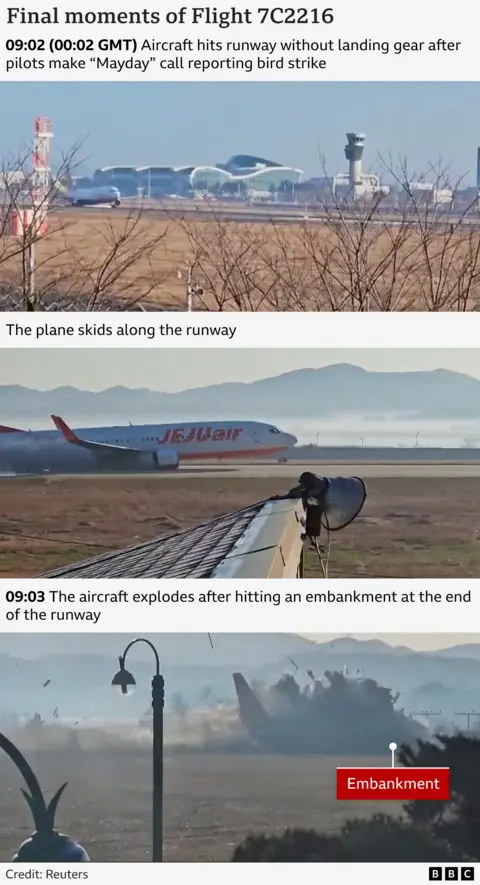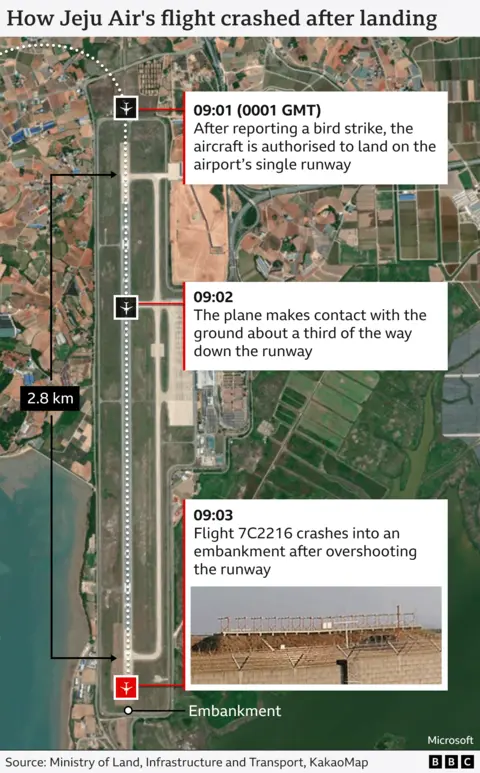Why was there a wall near runway at S Korea plane crash airport?
Aviation experts have raised questions about an "unusual" concrete wall near the runway and its role in the South Korea plane crash that killed 179 people.
Footage shows the Jeju Air plane coming off the runway before colliding with the wall and bursting into flames at Muan International Airport on Sunday.
Authorities investigating the cause of South Korea's worst-ever plane crash are considering the significance of the concrete wall's location about 250m (820ft) off the end of the runway.
Air safety expert David Learmount said that, had the "obstruction" not been there, the plane "would have come to rest with most - possibly all - those on board still alive".
The pilot reported that the plane had struck a bird and then aborted the original landing and requested permission to land from the opposite direction.
The plane came down some distance along the 2,800m runway and appeared to land without using its wheels or any other landing gear.
Mr Learmount said the landing was "as good as a flapless/gearless touchdown could be: wings level, nose not too high to avoid breaking the tail" and the plane had not sustained substantial damage as it slid along the runway.
"The reason so many people died was not the landing as such, but the fact that the aircraft collided with a very hard obstruction just beyond the runway end," he said.

Another aviation analyst agreed. Captain Ross Aimer, chief executive of Aero Consulting Experts, told Reuters news agency: "Unfortunately, that thing was the reason that everybody got killed, because they literally hit a concrete structure. It shouldn't have been there."
Christian Beckert, a Lufthansa pilot based in Munich, called the concrete structure "unusual", saying: "Normally, on an airport with a runway at the end, you don't have a wall."
The concrete structure holds a navigation system that assists aircraft landings - known as a localiser - according to South Korea's Yonhap News Agency.
At 4m high, it is covered with dirt and was raised to keep the localiser level with the runway to ensure it functions properly, Yonhap reported.
South Korea's transport ministry has said that other airports in the country and some overseas have the equipment installed with concrete structures. However officials will examine whether it should have been made with lighter materials that would break more easily upon impact.
Chris Kingswood, a pilot with 48 years' experience who has flown the same type of aircraft involved in the crash, told BBC News: "Obstacles within a certain range and distance of the runway are required to be frangible, which means that if an aircraft strikes them that they do break.
"It does seem unusual that it's such a rigid thing. The aircraft, from what I understand, was travelling very fast, landed a long way down the runway, so it will have gone a long way past the end of the runway... so where will you draw the line with that? That's certainly something that will be investigated.
"Aeroplanes are not strong structures - they are, by design, light to make them efficient in flight. They're not really designed to go high-speed on its belly so any kind of structure could cause the fuselage to break up and then be catastrophic.

"The fuel is kept in the wings so once the wing ruptures, then the potential for fire is significant.
"So it's not a given that if the wall had not been there, it would have been a completely different outcome."
Mr Kingswood said he would be "surprised if the airfield hadn't met all the requirements in accordance with industry standards".
"I suspect if we went around the airfields at a lot of major international airports... we would find a lot of obstacles that could similarly be accused of presenting a hazard," he added.
However former pilot John Cox, chief executive of Safety Operating Systems, said the runway design "absolutely (did) not" meet industry best practices, which preclude any hard structure within at least 300m (984ft) of the end of the runway.
Following the crash, it emerged that remarks in Muan International Airport's operating manual, uploaded early in 2024, said the concrete embankment was too close to the end of the runway.
The document, prepared by Korea Airports Corp, recommended the location of the equipment be reviewed during a planned expansion.
South Korea's director-general for airport policy, Kim Hong-rak, said the government would "review the relevant regulations and their application".
Aviation analyst Sally Gethin questioned whether the pilot knew the barrier was there, particularly given the plane was approaching from the opposite direction from the usual landing approach.
She told BBC News: "We need to know, were (the pilots) aware there was this hard boundary at the end?
"If they were directed by the control tower to reverse the use of the runway the second time around, that should come out in the investigation of the black boxes.
"I think there are so many questions."

At a news conference on Tuesday, Jeju Air's chief executive Kim Yi-bae would not be drawn when asked about the concrete wall.
Asked by a reporter if he thought the wall was a factor in the disaster, he did not give a direct answer and instead said it was right to call the plane crash the Jeju Air disaster, rather than the Muan Air disaster.
